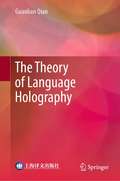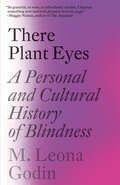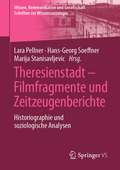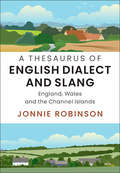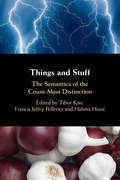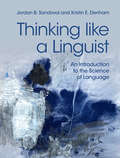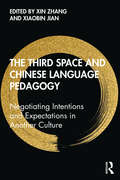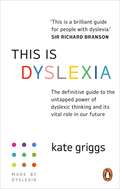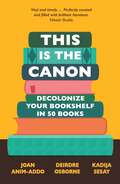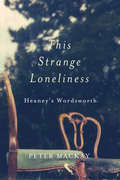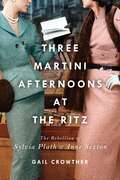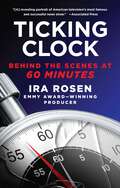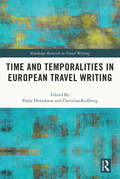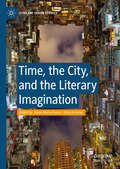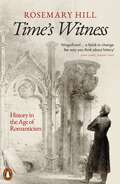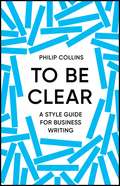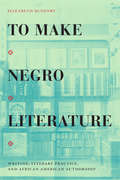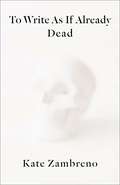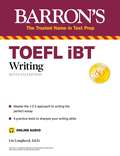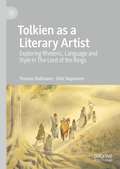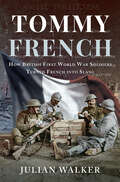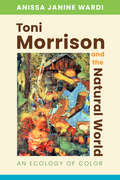- Table View
- List View
The Theory of Language Holography
by Guanlian QianThis book presents a method of linking the ordered structure of the cosmos with human thoughts: the theory of language holography. In the view presented here, the cosmos is in harmony with the human body and language, and human thoughts are holographic with the cosmos at the level of language. In a word, the holographic relation is nothing more than the bridge by means of which Guanlian Qian connects the cosmos, human, and language. This is a vitally important contribution to linguistic and philosophical studies that cannot be ignored.The book has two main focus areas: outer language holography and inner language holography. These two areas constitute the core of the dynamic and holistic view put forward in the theory of language holography. The book’s main properties can be summarized into the following points: First and foremost, it is a book created in toto by a Chinese scholar devoted to pragmatics, theoretical linguistics, and philosophy of language. Secondly, the book was accepted by a top Chinese publisher and was republished the second year, which reflected its value and appeal. Thirdly, in terms of writing style, the book is characterized by succinctness and logic. As a result, it reads fluidly and smoothly without redundancies, which is not that common in linguistic or even philosophical works. Lastly, as stated by the author in the introduction, “Creation is the development of previous capacities, but it is also the generation of new ones”; this book can be said to put this concept into practice. Overall, the book offers a unique resource to readers around the world who want to know more about the truly original and innovative studies of language in Chinese academia.
There Plant Eyes: A Personal and Cultural History of Blindness
by M. Leona GodinFrom Homer to Helen Keller, from Dune to Stevie Wonder, from the invention of braille to the science of echolocation, M. Leona Godin explores the fascinating history of blindness, interweaving it with her own story of gradually losing her sight. There Plant Eyes probes the ways in which blindness has shaped our ocularcentric culture, challenging deeply ingrained ideas about what it means to be &“blind.&” For millennia, blindness has been used to signify such things as thoughtlessness (&“blind faith&”), irrationality (&“blind rage&”), and unconsciousness (&“blind evolution&”). But at the same time, blind people have been othered as the recipients of special powers as compensation for lost sight (from the poetic gifts of John Milton to the heightened senses of the comic book hero Daredevil). Godin—who began losing her vision at age ten—illuminates the often-surprising history of both the condition of blindness and the myths and ideas that have grown up around it over the course of generations. She combines an analysis of blindness in art and culture (from King Lear to Star Wars) with a study of the science of blindness and key developments in accessibility (the white cane, embossed printing, digital technology) to paint a vivid personal and cultural history. A genre-defying work, There Plant Eyes reveals just how essential blindness and vision are to humanity&’s understanding of itself and the world.
Theresienstadt – Filmfragmente und Zeitzeugenberichte: Historiographie und soziologische Analysen (Wissen, Kommunikation und Gesellschaft)
by Lara Pellner Hans-Georg Soeffner Marija StanisavljevicIm Ghetto, Durchgangs- und Konzentrationslager Theresienstadt sind, unter erzwungener Beteiligung der Deportierten, filmische Aufzeichnungen entstanden und unter dem Titel „Theresienstadt – Ein Dokumentarfilm aus dem jüdischen Siedlungsgebiet“ bekannt geworden. Als besonders perfider Teil nationalsozialistischer Propaganda wirken diese Aufnahmen bis in die Gegenwart nach: Leugner des nationalsozialistischen Genozids verweisen bis heute auf diesen Film. Im Rahmen des Sammelbandes wird die Sonderstellung Theresienstadts auf unterschiedlichen Ebenen beleuchtet. Neben der Analyse von Zeitzeugeninterviews finden sich soziologische, philosophische und geschichtswissenschaftliche Betrachtungen der Umstände, Zustände und Besonderheiten Theresienstadts.
A Thesaurus of English Dialect and Slang: England, Wales and the Channel Islands
by Jonnie RobinsonA thesaurus of present-day vernacular English from Berwick-upon-Tweed to the Channel Islands, this unique record of everyday English celebrates established regional dialects, emerging new varieties and colloquial forms young and old. Based on a prestigious nationwide survey, BBC Voices Recordings, it documents the linguistic landscape of England, Wales and the Channel Islands in the 21st century, and includes over 3000 separate entries, drawn from over 200 locations across the country. Each entry contains information about the term's origins, location and the social distribution of its users. With links to original sound files and cross-references to complementary dictionary sources, it is an authoritative reference work for academic linguists, but its accessible presentation also makes it suitable for creative audiences and non-specialist language enthusiasts seeking authentic, up-to-date information on British English dialect and slang, and for English language teachers and learners as an invaluable educational tool.
Things and Stuff: The Semantics of the Count-Mass Distinction
by Tibor Kiss Francis Jeffry Pelletier Halima HusićA classical viewpoint claims that reality consists of both things and stuff, and that we need a way to discuss these aspects of reality. This is achieved by using +count terms to talk about things while using +mass terms to talk about stuff. Bringing together contributions from internationally-renowned experts across interrelated disciplines, this book explores the relationship between mass and count nouns in a number of syntactic environments, and across a range of languages. It both explains how languages differ in their methods for describing these two fundamental categories of reality, and shows the many ways that modern linguistics looks to describe them. It also explores how the notions of count and mass apply to 'abstract nouns', adding a new dimension to the countability discussion. With its pioneering approach to the fundamental questions surrounding mass-count distinction, this book will be essential reading for researchers in formal semantics and linguistic typology.
Thinking like a Linguist: An Introduction to the Science of Language
by Jordan B. Sandoval Kristin E. DenhamThis is an engaging introduction to the study of language for undergraduate or beginning graduate students, aimed especially at those who would like to continue further linguistic study. It introduces students to analytical thinking about language, but goes beyond existing texts to show what it means to think like a scientist about language, through the exploration of data and interactive problem sets. A key feature of this text is its flexibility. With its focus on foundational areas of linguistics and scientific analysis, it can be used in a variety of course types, with instructors using it alongside other information or texts as appropriate for their own courses of study. The text can also serve as a supplementary text in other related fields (Speech and Hearing Sciences, Psychology, Education, Computer Science, Anthropology, and others) to help learners in these areas better understand how linguists think about and work with language data. No prerequisites are necessary. While each chapter often references content from the others, the three central chapters on sound, structure, and meaning, may be used in any order.
The Third Space and Chinese Language Pedagogy: Negotiating Intentions and Expectations in Another Culture
by Xin Zhang; Xiaobin JianThe Third Space and Chinese Language Pedagogy presents the Third Space as a new frame through which foreign language pedagogy is conceptualized as a pedagogy of negotiating intentions and expectations in another culture. The field of Chinese as a foreign language (CFL) in the past decades has been expanding rapidly at the beginning and intermediate levels, yet it is lacking in scholarship on the true advanced level both in theory building and research-supported curriculum and material development. This book argues that it is time for CFL to go beyond merely satisfying the desire of gazing at the other, whether it is curiosity about the other or superiority over the other, to focusing on learning to work with the other. It reimagines the field as co-constructing a transcultural Third Space where learners are becoming experts in negotiating intentions and expectations in another culture. It presents a range of research-based CFL pedagogical scholarship and practices especially relevant to the advanced level and to the goal of enabling learners to go past fans or critics to become actors/players in the game of cross-lingual and intercultural cooperation.
This is Dyslexia: The definitive guide to the untapped power of dyslexic thinking and its vital role in our future
by Kate GriggsThe future needs Dyslexic Thinking! British social entrepreneur, founder and CEO of charity Made By Dyslexia, Kate Griggs has been shifting the narrative on dyslexia and educating people on its strengths since 2004. Having been surrounded by an extraordinary 'smorgasbord of Dyslexic Thinking' her whole life, Griggs knows the superpower of dyslexia all too well. With a forward from Sir Richard Branson, This is Dyslexia covers everything you need to understand, value and support Dyslexic Thinking. From offering practical advice on how to support the dyslexics in your life to breaking down the 6 Dyslexic Thinking skills in adults, Griggs shares her knowledge in an easily digestible guide. This is Dyslexia redefines and reshapes what it means to be dyslexic. It explores how it has shaped our past and how harnessing its powers and strengths is vital to our future.
This is the Canon: Decolonize Your Bookshelves in 50 Books
by Joan Anim-Addo Deirdre Osborne Kadija Sesay George'A vital and timely introduction to some of the best books I've ever read. Perfectly curated and filled with brilliant literature'Nikesh Shukla'The ultimate introduction to post-colonial literature for those who want to understand the classics and the pioneers in this exciting area of books'Symeon BrownThese are the books you should read. This is the canon.Joan Anim-Addo, Deirdre Osborne and Kadija Sesay have curated a decolonized reading list that celebrates the wide and diverse experiences of people from around the world, of all backgrounds and all races. It disrupts the all-too-often white-dominated 'required reading' collections that have become the accepted norm and highlights powerful voices and cultural perspectives that demand a place on our shelves. From literary giants such as Toni Morrison and Chinua Achebe to less well known (but equally vital) writers such as Caribbean novelist Earl Lovelace or Indigenous Australian author Tony Birch, the novels recommended here are in turn haunting and lyrical; innovative and inspiring; edgy and poignant.The power of great fiction is that readers have the opportunity to discover new worlds and encounter other beliefs and opinions. This is the Canon offers a rich and multifaceted perspective on our past, present and future which deserves to be read by all bibliophiles - whether they are book club members or solitary readers, self-educators or teachers.
This is the Canon: Decolonize Your Bookshelves in 50 Books
by Joan Anim-Addo Deirdre Osborne Kadija Sesay George'A vital and timely introduction to some of the best books I've ever read. Perfectly curated and filled with brilliant literature'Nikesh Shukla'The ultimate introduction to post-colonial literature for those who want to understand the classics and the pioneers in this exciting area of books'Symeon BrownThese are the books you should read. This is the canon.Joan Anim-Addo, Deirdre Osborne and Kadija Sesay have curated a decolonized reading list that celebrates the wide and diverse experiences of people from around the world, of all backgrounds and all races. It disrupts the all-too-often white-dominated 'required reading' collections that have become the accepted norm and highlights powerful voices and cultural perspectives that demand a place on our shelves. From literary giants such as Toni Morrison and Chinua Achebe to less well known (but equally vital) writers such as Caribbean novelist Earl Lovelace or Indigenous Australian author Tony Birch, the novels recommended here are in turn haunting and lyrical; innovative and inspiring; edgy and poignant.The power of great fiction is that readers have the opportunity to discover new worlds and encounter other beliefs and opinions. This is the Canon offers a rich and multifaceted perspective on our past, present and future which deserves to be read by all bibliophiles - whether they are book club members or solitary readers, self-educators or teachers.
This Strange Loneliness: Heaney's Wordsworth
by Peter MackayThis Strange Loneliness is the first comprehensive account of the poetic relationship between Seamus Heaney and William Wordsworth. Peter Mackay explores how Heaney repeatedly turns to the Romantic poet's work for inspiration, corroboration, and amplification, and as a model for the fortifying power of poetry itself, which offers the fundamental lesson that "it is on this earth 'we find our happiness, or not at all.'"Through an in-depth look at archival materials, and at uncollected poems and prose by Heaney, Mackay traces the evolution of Heaney's readings of Wordsworth throughout his career, revealing their shared interest in the connections between poetry and education, the possibility of a beneficial understanding of poetic influence, the complexities of place and displacement, ideas of transcendence, and ultimately the importance of "late style": later poems by Wordsworth might prove a cautionary tale, as well as example, for any poet. Placing Heaney's readings within their political, historical, and poetic contexts the book also explores how he negotiated the complex relationship between Irish and British culture and identity to claim a persistent form of kinship, and forge a strange community, with the Romantic poet.With illuminating readings that reveal new contexts to and currents in Heaney's work, This Strange Loneliness is a powerful evocation of the Irish poet's sense of the "uplift" that poetry can provide.
Three-Martini Afternoons at the Ritz: The Rebellion of Sylvia Plath & Anne Sexton
by Gail CrowtherA vividly rendered and empathetic exploration of how two of the greatest poets of the 20th century—Sylvia Plath and Anne Sexton—became bitter rivals and, eventually, friends. Introduced at a workshop in Boston University led by the acclaimed and famous poet Robert Lowell, Sylvia Plath and Anne Sexton formed a friendship that would soon evolve into a fierce rivalry, colored by jealousy and respect in equal terms. In the years that followed, these two women would not only become iconic figures in literature, but also lead curiously parallel lives haunted by mental illness, suicide attempts, self-doubt, and difficult personal relationships. With weekly martini meetings at the Ritz to discuss everything from sex to suicide, theirs was a relationship as complex and subversive as their poetry. Based on in-depth research and unprecedented archival access, Three-Martini Afternoons at the Ritz is a remarkable and unforgettable look at two legendary poets and how their work has turned them into lasting and beloved cultural figures.
Ticking Clock: Behind the Scenes at 60 Minutes
by Ira RosenTwo-time Peabody Award-winning writer and producer Ira Rosen reveals the intimate, untold stories of his decades at America’s most iconic news show. It’s a 60 Minutes story on 60 Minutes itself. When producer Ira Rosen walked into the 60 Minutes offices in June 1980, he knew he was about to enter television history. His career catapulted him to the heights of TV journalism, breaking some of the most important stories in TV news. But behind the scenes was a war room of clashing producers, anchors, and the most formidable 60 Minutes figure: legendary correspondent Mike Wallace.Based on decades of access and experience, Ira Rosen takes readers behind closed doors to offer an incisive look at the show that invented TV investigative journalism. With surprising humor, charm, and an eye for colorful detail, Rosen delivers an authoritative account of the unforgettable personalities that battled for prestige, credit, and the desire to scoop everyone else in the game. As Mike Wallace’s top producer, Rosen reveals the interview secrets that made Wallace’s work legendary, and the flaring temper that made him infamous. Later, as senior producer of ABC News Primetime Live and 20/20, Rosen exposes the competitive environment among famous colleagues like Diane Sawyer and Barbara Walters, and the power plays between correspondents Chris Wallace, Anderson Cooper, and Chris Cuomo. A master class in how TV news is made, Rosen shows readers how 60 Minutes puts together a story when sources are explosive, unreliable, and even dangerous. From unearthing shocking revelations from inside the Trump White House, to an outrageous proposition from Ghislaine Maxwell, to interviewing gangsters Joe Bonanno and John Gotti Jr., Ira Rosen was behind the scenes of 60 Minutes' most sensational stories.Highly entertaining, dishy, and unforgettable, Ticking Clock is a never-before-told account of the most successful news show in American history.
Time and Temporalities in European Travel Writing (Routledge Research in Travel Writing)
by Paula Henrikson Christina KullbergThis book is a collective effort to investigate and problematise notions of time and temporality in European travel writing from the late medieval period up to the late nineteenth century. It brings together nine researchers in European travel writing and covers a wide range of areas, travel genres, and languages, coherently integrated around the central theme of time and temporalities. Taken together, the contributions consider how temporal aspects evolve and change in regard to spatial, historical, and literary contexts. In a chapter-by-chapter account this volume thus offers various case studies that address the issue of temporality by showing, for example, how time is inscribed in landscape, how travellers’ encounters with other temporalities informed other disciplines; it interrogates the idea of "cultural temporalities" in regard to a tension between past and future, passivity and progression; and focuses on how time is entangled in identity construction proper to travelogues.
Time, the City, and the Literary Imagination (Literary Urban Studies)
by Anne-Marie Evans Kaley KramerTime, the City, and the Literary Imagination explores the relationship between the constructions and representations of the relationship between time and the city in literature published between the late eighteenth century and the present. This collection offers a new way of reading the literary city by tracing the ways in which the relationship between time and urban space can shape literary narratives and forms. The essays consider the representation of a range of literary cities from across the world and consider how an understanding of time, and time passing, can impact on our understanding of the primary texts. Literature necessarily deals with time, both as a function of storytelling and as an experience of reading. In this volume, the contributions demonstrate how literature about cities brings to the forefront the relationship between individual and communal experience and time.
Time's Witness: History in the Age of Romanticism
by Rosemary HillFrom the Wolfson Prize-winning author of God's Architect: Pugin and the Building of Romantic BritainBetween the fall of the Bastille in 1789 and the opening of the Great Exhibition in 1851, history changed. The grand narratives of the Enlightenment, concerned with kings and statesmen, gave way to a new interest in the lives of ordinary people. Oral history, costume history, the history of food and furniture, of Gothic architecture, theatre and much else were explored as never before. Antiquarianism, the study of the material remains of the past, was not new, but now hundreds of men - and some women - became antiquaries and set about rediscovering their national history, in Britain, France and Germany.The Romantic age valued facts, but it also valued imagination and it brought both to the study of history. Among its achievements were the preservation of the Bayeux Tapestry, the analysis and dating of Gothic architecture, and the first publication of Beowulf. It dispelled old myths, and gave us new ones: Shakespeare's birthplace, clan tartans and the arrow in Harold's eye are among their legacies. From scholars to imposters the dozen or so antiquaries at the heart of this book show us history in the making.
To Be Clear
by Philip CollinsThe bad reputation many businesses have in our time is intimately connected to the lack of clarity in the language they use. TO BE CLEAR is a call to arms, urging businesses to stop using the language of nonsense and start using language that has clarity and meaning. It's a lucid, entertaining and practical guide for anyone who cares about language to help them improve their communications and thus also their business practices.
To Be Clear
by Philip CollinsThe bad reputation many businesses have in our time is intimately connected to the lack of clarity in the language they use. TO BE CLEAR is a call to arms, urging businesses to stop using the language of nonsense and start using language that has clarity and meaning. It's a lucid, entertaining and practical guide for anyone who cares about language to help them improve their communications and thus also their business practices.
To Make Negro Literature: Writing, Literary Practice, and African American Authorship
by Elizabeth McHenryIn To Make Negro Literature Elizabeth McHenry traces African American authorship in the decade following the 1896 legalization of segregation. She shifts critical focus from the published texts of acclaimed writers to unfamiliar practitioners whose works reflect the unsettledness of African American letters in this period. Analyzing literary projects that were unpublished, unsuccessful, or only partially achieved, McHenry recovers a hidden genealogy of Black literature as having emerged tentatively, laboriously, and unevenly. She locates this history in books sold by subscription, in lists and bibliographies of African American authors and books assembled at the turn of the century, in the act of ghostwriting, and in manuscripts submitted to publishers for consideration and the letters of introduction that accompanied them. By attending to these sites and prioritizing overlooked archives, McHenry reveals a radically different literary landscape, revising concepts of Black authorship and offering a fresh account of the development of “Negro literature” focused on the never published, the barely read, and the unconventional.
To Write as if Already Dead (Rereadings)
by Kate ZambrenoTo Write As If Already Dead circles around Kate Zambreno’s failed attempts to write a study of Hervé Guibert’s To the Friend Who Did Not Save My Life. In this diaristic, transgressive work, the first in a cycle written in the years preceding his death, Guibert documents with speed and intensity his diagnosis and disintegration from AIDS and elegizes a character based on Michel Foucault.The first half of To Write As If Already Dead is a novella in the mode of a detective story, searching after the mysterious disappearance of an online friendship after an intense dialogue on anonymity, names, language, and connection. The second half, a notebook documenting the doubled history of two bodies amid another historical plague, continues the meditation on friendship, solitude, time, mortality, precarity, art, and literature.Throughout this rigorous, mischievous, thrilling not-quite study, Guibert lingers as a ghost companion. Zambreno, who has been pushing the boundaries of literary form for a decade, investigates his methods by adopting them, offering a keen sense of the energy and confessional force of Guibert’s work, an ode to his slippery, scarcely classifiable genre. The book asks, as Foucault once did, “What is an author?” Zambreno infuses this question with new urgency, exploring it through the anxieties of the internet age, the ethics of friendship, and “the facts of the body”: illness, pregnancy, and death.
TOEFL iBT Writing (Barron's Test Prep)
by Lin Lougheed Ph.D.TOEFL iBT Writing prepares students to succeed on the TOEFL's Independent Task, the all-important essay question, and on the Integrated Task, which combines reading, listening, and writing skills.The author presents a three-step program designed to help students write like native speakers of English. His coaching entails gathering ideas, organizing details, and developing the chosen topic into clear, grammatical written English. He also provides exercises in proofreading and editing. Model essays and model integrated tasks are included for students to read and analyze. Audio lectures typical of those presented on actual tests are included online.Lin Lougheed presents a three-step program designed to help students write like native speakers of English. The three steps include:Gathering ideasOrganizing detailsDeveloping the chosen topic into clear, grammatical written EnglishThe book also provides:Exercises in proofreading and editingModel essays and integrated tasks to read and analyzeOnline audio lectures similar to those presented on actual testsPublisher's Note: Products purchased from Third Party sellers are not guaranteed by the publisher for quality, authenticity, or access to any online entitlements included with the product.
Tolkien as a Literary Artist: Exploring Rhetoric, Language and Style in The Lord of the Rings
by Thomas Kullmann Dirk SiepmannThis book takes a fresh look at Tolkien’s literary artistry from the points of view of both linguistics and literary history, with the aim of shedding light on the literary techniques used in The Lord of the Rings. The authors study Tolkien’s use of words, style, narrative techniques, rhetoric and symbolism to highlight his status as literary artist. Dirk Siepmann uses a corpus stylistic approach to analyse Tolkien’s vocabulary and syntax, while Thomas Kullmann uses discourse theory, literary history and concepts of intertextuality to explore Tolkien’s literary techniques, relating them to the history of English fiction and poetry. Issues discussed include point of view, speeches, story-telling, landscape descriptions, the poems inserted into the body of the narrative, and the role of language in the characterization of the novel’s protagonists. This book will be of particular interest to students and scholars of literature, corpus linguistics and stylistics, as well as Tolkien fans and specialists.
Tommy French: How British First World War Soldiers Turned French into Slang
by Julian Walker‘Napoo’, ‘compray’, ‘san fairy ann’, ‘toot sweet’ are anglicized French phrases that came into use on the Western Front during the First World War as British troops struggled to communicate in French. Over four years of war they created an extraordinary slang which reflects the period and brings the conflict to mind whenever it is heard today. Julian Walker, in this original and meticulously researched book, explores the subject in fascinating detail. In the process he gives us an insight into the British soldiers’ experience in France during the war and the special language they invented in order to cope with their situation. He shows how French place-names were anglicized as were words for food and drink, and he looks at what these slang terms tell us about the soldiers’ perception of France, their relationship with the French and their ideas of home. He traces the spread of ‘Tommy French’ back to the Home Front, where it was popularized in songs and on postcards, and looks at the French reaction to the anglicization of their language.
Tommy French: How British First World War Soldiers Turned French into Slang
by Julian Walker‘Napoo’, ‘compray’, ‘san fairy ann’, ‘toot sweet’ are anglicized French phrases that came into use on the Western Front during the First World War as British troops struggled to communicate in French. Over four years of war they created an extraordinary slang which reflects the period and brings the conflict to mind whenever it is heard today. Julian Walker, in this original and meticulously researched book, explores the subject in fascinating detail. In the process he gives us an insight into the British soldiers’ experience in France during the war and the special language they invented in order to cope with their situation. He shows how French place-names were anglicized as were words for food and drink, and he looks at what these slang terms tell us about the soldiers’ perception of France, their relationship with the French and their ideas of home. He traces the spread of ‘Tommy French’ back to the Home Front, where it was popularized in songs and on postcards, and looks at the French reaction to the anglicization of their language.
Toni Morrison and the Natural World: An Ecology of Color
by Anissa Janine WardiCritics have routinely excluded African American literature from ecocritical inquiry despite the fact that the literary tradition has, from its inception, proved to be steeped in environmental concerns that address elements of the natural world and relate nature to the transatlantic slave trade, plantation labor, and nationhood. Toni Morrison’s work is no exception. Toni Morrison and the Natural World: An Ecology of Color is the first full-length ecocritical investigation of the Nobel Laureate’s novels and brings to the fore an unequaled engagement between race and nature.Morrison’s ecological consciousness holds that human geographies are enmeshed with nonhuman nature. It follows, then, that ecology, the branch of biology that studies how people relate to each other and their environment, is an apt framework for this book. The interrelationships and interactions between individuals and community, and between organisms and the biosphere, are central to this analysis. They highlight that the human and nonhuman are part of a larger ecosystem of interfacings and transformations. Toni Morrison and the Natural World is organized by color, examining soil (brown) in The Bluest Eye and Paradise; plant life (green) in Song of Solomon, Beloved, and Home; bodies of water (blue) in Tar Baby and Love; and fire (orange) in Sula and God Help the Child. By providing a racially inflected reading of nature, Toni Morrison and the Natural World makes an important contribution to the field of environmental studies and provides a landmark for Morrison scholarship.
